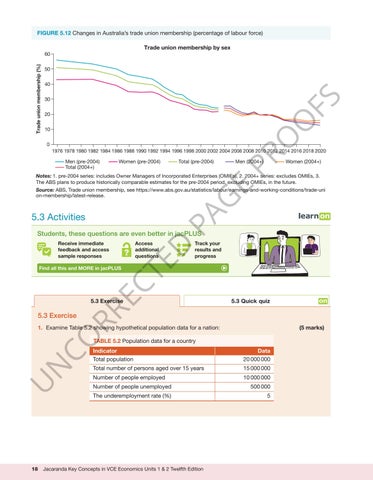“c05TheChangingLabourMarket_PrintPDF” — 2022/6/3 — 13:15 — page 18 — #18
FIGURE 5.12 Changes in Australia’s trade union membership (percentage of labour force)
Trade union membership by sex
50
FS
40 30
O
20 10
O
Trade union membership (%)
60
0 Men (pre-2004) Total (2004+)
Women (pre-2004)
Total (pre-2004)
PR
1976 1978 1980 1982 1984 1986 1988 1990 1992 1994 1996 1998 2000 2002 2004 2006 2008 2010 2012 2014 2016 2018 2020 Men (2004+)
Women (2004+)
E
Notes: 1. pre-2004 series: includes Owner Managers of Incorporated Enterprises (OMIEs), 2. 2004+ series: excludes OMIEs, 3. The ABS plans to produce historically comparable estimates for the pre-2004 period, excluding OMIEs, in the future.
PA
G
Source: ABS, Trade union membership, see https://www.abs.gov.au/statistics/labour/earnings-and-working-conditions/trade-uni on-membership/latest-release.
5.3 Activities
Students, these questions are even better in jacPLUS
TE
Track your results and progress
CO RR EC
Find all this and MORE in jacPLUS
Access additional questions
D
Receive immediate feedback and access sample responses
5.3 Exercise
5.3 Quick quiz
5.3 Exercise
1. Examine Table 5.2 showing hypothetical population data for a nation:
(5 marks)
U
N
TABLE 5.2 Population data for a country
18
Indicator Total population
Data 20 000 000
Total number of persons aged over 15 years
15 000 000
Number of people employed
10 000 000
Number of people unemployed
500 000
The underemployment rate (%)
5
Jacaranda Key Concepts in VCE Economics Units 1 & 2 Twelfth Edition





















































